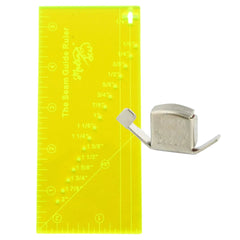How to Make a Floor Pillow (Sewing Tutorial)
I like sitting on the floor and my children do too, so this week's project is a DIY floor pillow! Pillows can be very expensive in stores. However, the most expensive item if you’re making it yourself is the filling. If you have a fabric stash and some cord, the rest will cost you close to nothing. Just reserve one afternoon of sewing me-time and learn how to make a floor pillow yourself!
Use a nice upholstery fabric if you want a long lasting pillow, I used a medium-weight cotton, so I know I’m taking a risk here :-).
How to Calculate Fabric for a Floor Pillow
You can make a floor pillow any size you like, but the instructions here are for a standard 21” round floor pillow. You’ll need to start with two 22” circles. You need one 7”x69” strip for the side panel, and two piping/cording strips of 1.5”x69” each.
If you want to make a pillow in another dimension, decide the diameter first. To figure out the length, the side panel, and the piping strips, you need to calculate the circumference of the circle: the diameter of the circle x 3.14 (π).
How to Cut a Large Fabric Circle
This is how I cut a large circle out of a fabric panel.
1. Cut a square the size of the diameter of your pillow: 22”x22”.
2. Fold your fabric in half twice in different directions, so that you’ve folded the fabric into four quarters.
3. Take a pen, a string, and a ruler. Tie the end of the string securely around your pen or pencil about an inch from the tip. You now have a homemade compass.
Place your pen vertically with the tip on the ruler. Mark the radius on your string. The radius is half your diameter, in this case 9”.
4. Place this marked point at the center of the square and use your compass to draw one quarter of a circle.
5. Once your quarter-circle is drawn, cut through all layers with scissors or your rotary cutter.
How to Make Piping for a Pillow
Our quilting blogger, Carole, made a great tutorial about piping and cording. Have a look if you want to make the piping yourself. Make sure you cut your fabric on the bias because you are working around curves. But, of course, you can also buy some ready made piping! Get 138 inches of piping.
How to Add a Zipper to the Floor Pillow
If you want a zipper in your floor pillow case, I would suggest using a centered zipper. I explained how to sew a centered zipper in this pillow tutorial. You will have to add the zipper insert in the bottom circle, or in the side panel.
If you want the zipper in the circle, you need to change one of the two circles: Draw half a circle on your double folded fabric and add seam allowance to the diameter where you want the zipper. The two half-circles are the zipper casing pieces.
If you are inserting the zipper in the side panel, cut the strip shorter, about the length of the zipper. Then draw and cut that piece wider by adding the seam allowance twice. Cut in half lengthwise And then you have your two zipper casing pieces. After you add the zipper, you can attach the zipper piece to the side panel strip and continue.
How to Add a Handle to the Floor Pillow
The final handle of this floor pillow will be 2” wide, when you use the suggested dimensions.
1. Cut a strip, 8” wide and the length of the width of the long fabric strip + 1 inch, so in my case, 7” + 1” = 8”x8”.
2. Fold the strip in half lengthwise and press.
3. Fold each half in towards the middle and press..
4. Close and topstitch along the edges of the handle. I used an edge joining foot for clean edge stitches. The guide makes sure you stay on that edge and don’t fall off 🙂
5. Pin the handle to the right side of the fabric strip that will be the side panel on your finished pillow/ You’ll sew the handle into the pillow when you assemble the sides of the floor pillow. You can baste the handle on now, if you like.
How To Attach The Piping To The Floor Pillow
To start, you need your side panel, the two circles, and the two long piping strips.
Take your piping and line the raw edges around the circle with the right side of the fabric facing up. Pin together and use a lot of pins.
Head to your sewing machine and sew the piping to the circle all the way around. Don’t attach the first inch of the strip yet–you want to be able to join the piping ends so that the edges don’t show.
Using a piping or beading foot enables you to stitch close to the piping in a controlled way.
These two presser feet come with the 32 Ultimate Presser Foot Set. The beading foot can be used with thicker cord than the piping foot, but you have to put your needle off center to be able to use it to stitch next to the piping. If you use a very thick cord, too thick to fit under these feet, you can also use an adjustable zipper foot to stitch close to the cord. All of our presser feet are in this section of the webstore.
When you’ve attached the piping band all around the circle, stop and follow the next seven steps to join the piping ends in a clean way.
1. Cut both piping ends at a 45° angle–the strip ends need to overlap 1- 2 inches.
2. Rip open one end of the piping about 2 inches.
3. Measure and cut off the cord so it matches.
4. Fold in the fabric of the side you ripped open.
5. Fold around the other end of the piping.
6. Pin down.
7. Continue sewing.
Do the same with the other circle and piping strip. The two circles should look identical.
Assemble the Floor Pillow Pieces and Stuff with Filling
Take the long fabric strip–your side panel. Fold one short end in ½ inch and press.
Line up the edges of the circle with the side panel, right sides facing, and pin around.
If you want a handle, it should be pinned to the side panel before this step so that it will be sewn in between the side panel and the circle. Sew all around.
At the end, where the two short side panel ends meet, put the two ends one over the other and sew until the one that will be seen at the right side is attached.
Pin the other circle to the side panel and follow the same steps.
Turn the floor pillow right side out through the opening between the strip ends. If you added a zipper, you could also turn the floor pillow right side out through the zipper.
Insert the filling. You may need a lot of filling depending on how firm you want your pillow. Mine swallowed about 1 kilo of synthetic filling plus the filling of two old pillows, and it could still use some more, I think.
Close the opening with an invisible hand stitch. Make this one a firm invisible stitch. It will get some pressure from the filling! I’m considering inserting a scratch band to close this opening better. I must admit, it’s the weak point of my pillow. A zipper might have been better. Does anyone have another idea to close this opening?
When you are happy with the closure, velcro, zipper or handsewn, you are all done!!
I hope you enjoying learning how to sew a floor pillow. It’s such a fun sewing project that makes the perfect gift for kids or for anyone for that matter. It takes a little more time than sewing a regular pillow but it is very original, don’t you thin? I really like this pillow as an extra seat in front of our television.
Let me know what other sewing tutorials you’d like to see on the MadamSew Sewing and Quilting Blog. And if you have any questions, just let me know an@madamsew.com
Happy Sewing!
An
Sewing blogger for MadamSew.com
Follow us on Instagram, Facebook or YouTube and get more sewing inspiration!
















